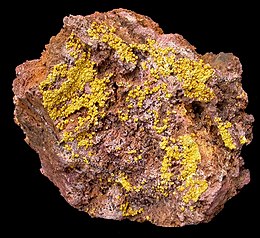Soddyite
| Soddyite | |
|---|---|
 A piece of rock from in the Democratic Republic of Congo containing yellow crystals of soddyite | |
| General | |
| Category | Nesosilicates |
| Formula (repeating unit) | (UO2)2SiO4·2H2O |
| IMA symbol | Sod[1] |
| Strunz classification | 9.AK.05 |
| Dana classification | 53.03.03.01 |
| Crystal system | Orthorhombic |
| Crystal class | Dipyramidal (mmm) H-M symbol: (2/m 2/m 2/m) |
| Space group | F ddd |
| Unit cell | 1,745.03 ų |
| Identification | |
| Color | Canary yellow to amber yellow |
| Cleavage | Perfect on {001}, good on {111} |
| Mohs scale hardness | 3 - 4 |
| Luster | Vitreous, greasy, dull |
| Streak | Yellow |
| Diaphaneity | Transparent, translucent, opaque |
| Density | 4.627 |
| Optical properties | Biaxial (-) |
| Refractive index | nα = 1.650 - 1.654, nβ = 1.685, nγ = 1.699 - 1.715 |
| Birefringence | 0.049 - 0.061 |
| Dispersion | Relatively weak |
| Ultraviolet fluorescence | Weak orange yellow |
| Other characteristics | |
Soddyite is a mineral of uranium. It has yellow crystals and usually mixed with curite in oxidized uranium ores. It is named after Frederick Soddy (1877–1956), british radiochemist and physicist. It's been a valid species since 1922.[2][3][4]
References[]
- ^ Warr, L.N. (2021). "IMA–CNMNC approved mineral symbols". Mineralogical Magazine. 85 (3): 291–320. Bibcode:2021MinM...85..291W. doi:10.1180/mgm.2021.43. S2CID 235729616.
- ^ Webmineral data for soddyite
- ^ Mindat information page for Soddyite
- ^ Handbook of Mineralogy
Categories:
- Silicate mineral stubs
- Uranium(VI) minerals
- Nesosilicates
- Orthorhombic minerals
- Minerals in space group 70